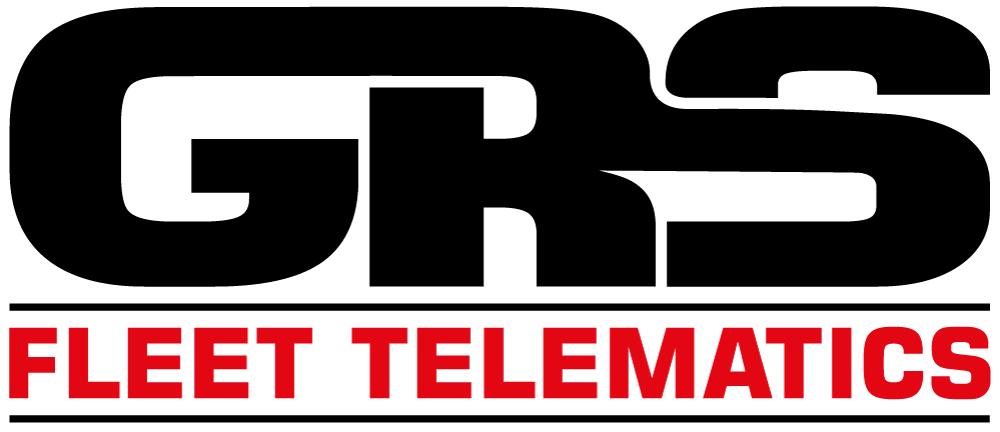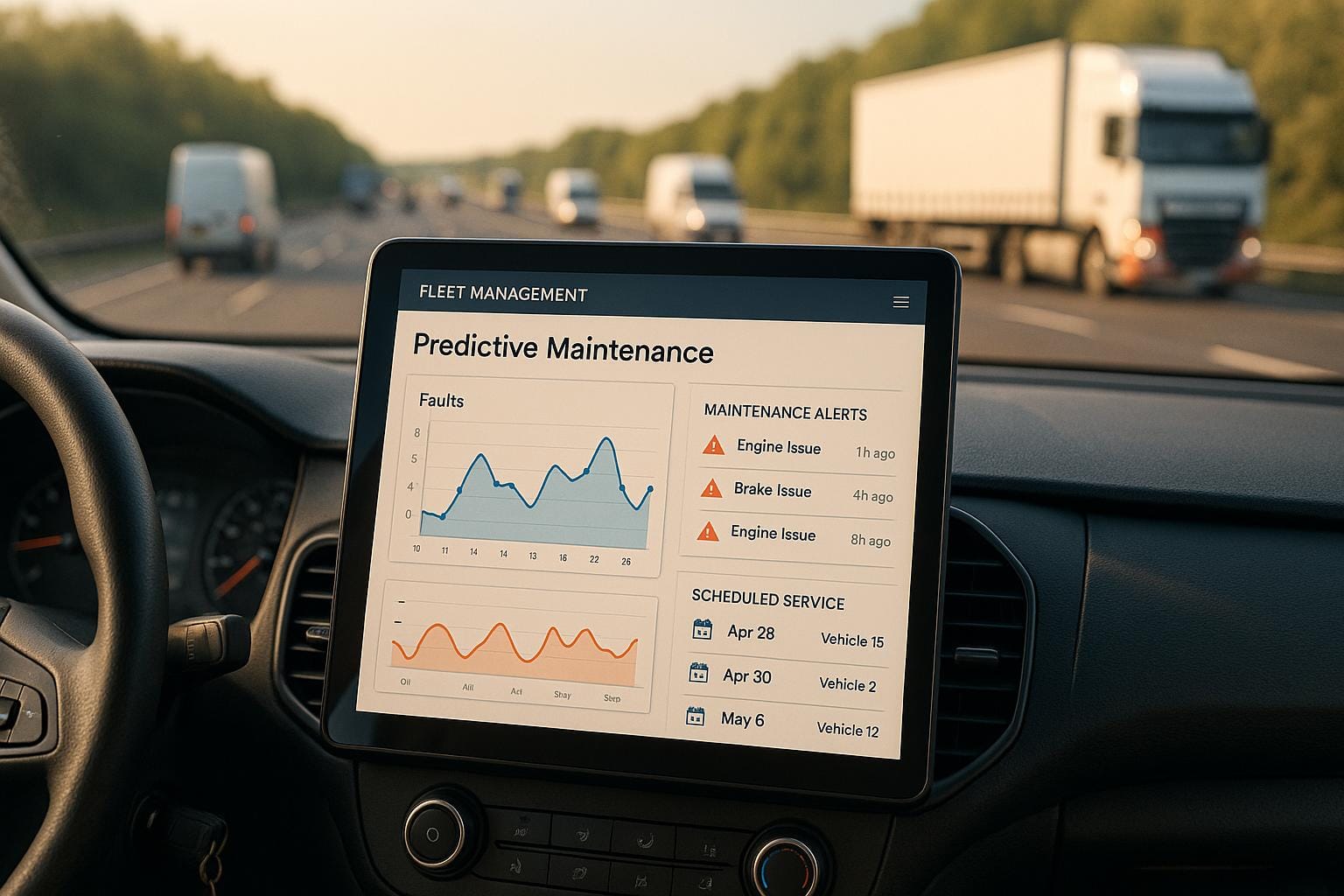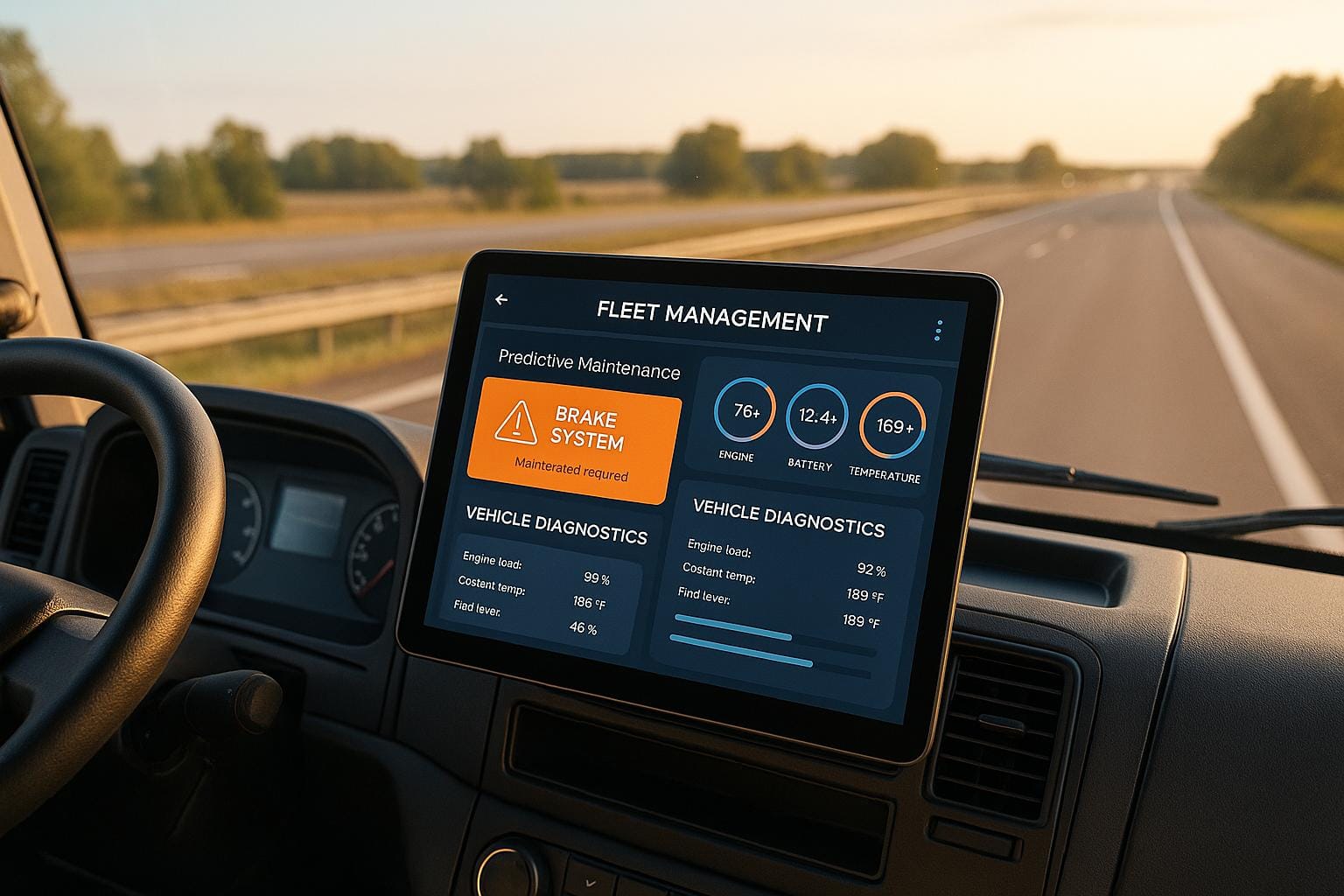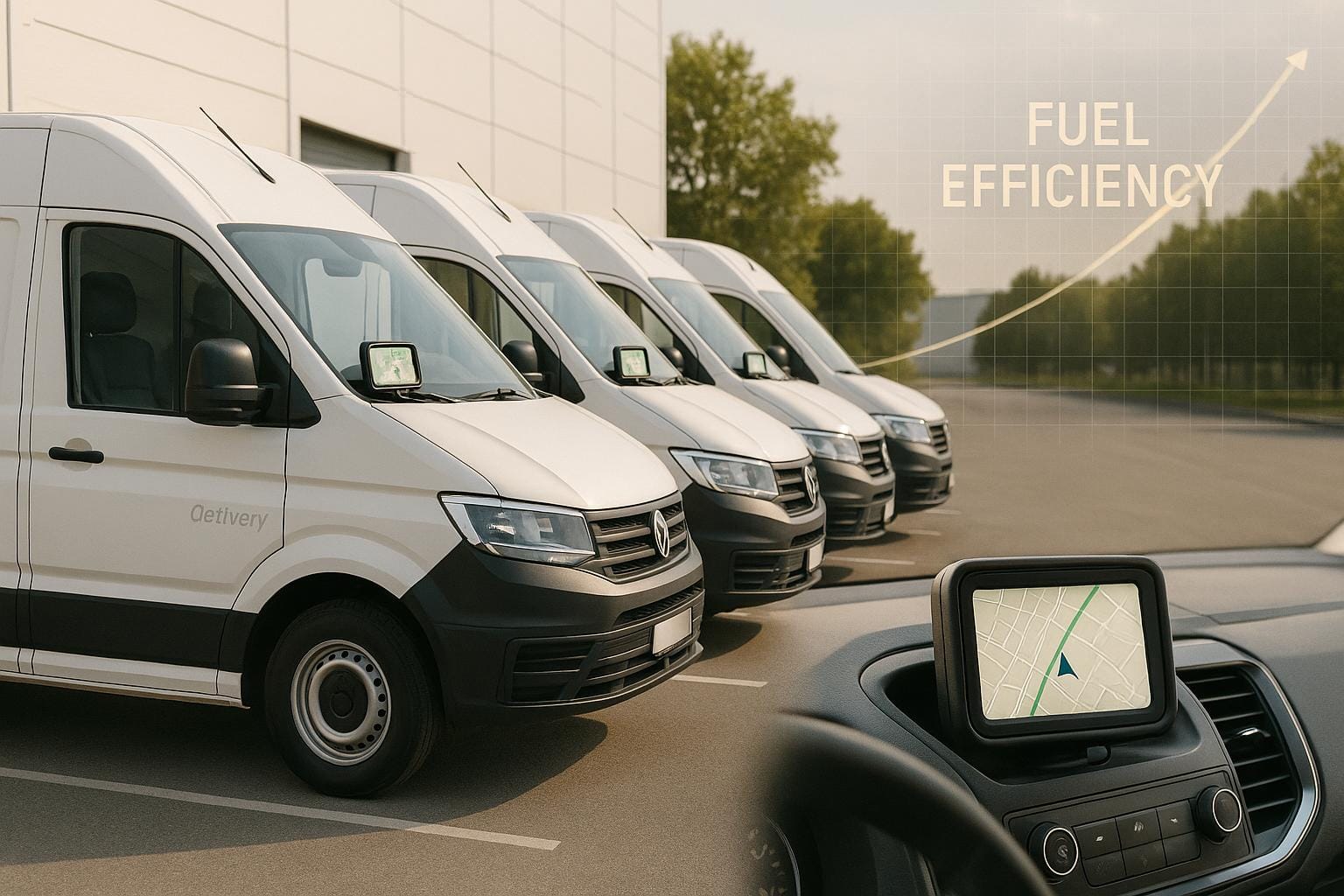Every day, 22 vans are stolen in the UK, costing businesses thousands in losses. Landscaping companies are particularly at risk, with expensive tools and equipment stored in their vehicles. Van trackers offer a practical solution, combining GPS tracking, theft prevention, and fleet management to safeguard assets and improve operations.
Key Benefits of Van Trackers:
- Real-time GPS tracking: Monitor vehicle locations to prevent theft and optimise routes.
- Theft prevention tools: Features like remote immobilisation and geofencing stop thefts and aid recovery.
- Lower costs: Reduce insurance premiums by up to 35% and save on fuel and maintenance.
- Improved fleet management: Track driver behaviour, schedule maintenance, and enhance efficiency.
With theft costing UK businesses over £4.7 billion annually, van trackers are a low-cost, high-impact investment starting at just £35. Protect your fleet, save money, and keep your landscaping business running smoothly.
Top 4 BEST GPS Trackers (2025) | Features & Installation | SafeTag Trackers
How Van Trackers Work
Van tracking technology integrates multiple systems to help secure and monitor landscaping fleets. Understanding these systems can assist business owners in making smart decisions to protect their valuable vehicles. Each component plays a specific role in enhancing fleet security.
GPS Tracking for Real-Time Fleet Monitoring
At the heart of most van tracking systems is GPS technology. Using satellite positioning, GPS trackers allow landscaping managers to monitor vehicle locations with precision and in real time. This constant visibility is particularly useful for managing crews spread across different locations.
GPS systems rely on a network of satellites to determine the exact position of each vehicle. For landscaping businesses operating in rural or remote areas, this ensures uninterrupted tracking, even in places with weak mobile signals. Additionally, detailed movement logs can be used to optimise routes and improve scheduling.
Real-time tracking also helps managers make quicker decisions, such as dispatching the nearest crew to urgent jobs or adjusting schedules on the fly. Accurate tracking improves customer communication by providing reliable arrival times and can lead to cost savings by cutting down on unnecessary overtime. The data also supports immediate security responses, such as activating vehicle immobilisation during a theft attempt.
Remote Immobilisation and Theft Prevention
Van trackers don’t just track location - they also help prevent theft with remote immobilisation. This feature allows fleet managers to disable a vehicle’s engine remotely by sending a signal to its engine management system. Once immobilised, the vehicle cannot be restarted after the ignition is turned off. Importantly, this system only activates when the vehicle is stationary and turned off, ensuring safety.
When combined with GPS tracking, remote immobilisation provides a powerful tool for recovering stolen vehicles. Managers can pinpoint a vehicle’s location and disable it, significantly increasing the chances of recovery. Beyond theft prevention, this feature can also be used to enforce operational policies, such as restricting vehicle use outside authorised hours or ensuring maintenance is completed before further use.
To further deter thieves, many companies display "GPS Controlled" stickers on their vehicles. Insurance providers often recognise the added security of remote immobilisation, offering reduced premiums for vehicles equipped with this technology.
Geofencing for Better Security
Geofencing adds another layer of protection by creating virtual boundaries around specific areas. Landscaping businesses can set up geofences around customer sites, company premises, or approved parking zones. Alerts are triggered if a vehicle enters or leaves these boundaries, particularly outside working hours, enabling managers to respond quickly to unauthorised movements.
This feature is especially useful for overnight security, as it keeps an eye on vehicles parked in less secure locations. Geofencing also helps ensure crews arrive at job sites on time and stay within designated areas, providing reliable records for audits and billing.
When used alongside remote immobilisation, geofencing creates a robust security system. The combination reduces the time available for potential theft and increases the chances of recovering stolen vehicles. Geofencing can also be adjusted to suit seasonal projects or temporary job sites, making it a flexible and effective tool for fleet security.
Together, these technologies make van trackers an essential asset for landscaping businesses, offering both security and operational efficiency. By integrating GPS tracking, remote immobilisation, and geofencing, companies can better safeguard their fleets while improving day-to-day management.
Security Benefits of Van Trackers for Landscaping Fleets
Van trackers play a key role in safeguarding landscaping businesses, offering protection for valuable equipment and helping to cut costs through reduced theft and lower insurance premiums. Advanced features, like dual-tracker systems, take this security to another level.
Dual-Tracker Systems for Added Protection
Dual-tracker systems combine a primary tracker with a hidden backup device, ensuring constant monitoring even if the main unit is tampered with. If thieves disable the visible tracker, the concealed one remains operational, providing uninterrupted security.
Blake M., who runs a landscaping business, shared how this technology saved his equipment:
I got notified that it was moving at 1 am. The police got there before the thieves could roll it over to the gate, cut the lock, and hook it up to their truck.
The numbers back up the importance of robust tracking systems. Equipment theft costs businesses nearly £1 billion each year, but only 7% of stolen machinery is ever recovered. Dual-trackers can make the difference between a devastating loss and a successful recovery.
Securing Expensive Machinery
Landscaping fleets often carry high-value tools and machinery, making them prime targets for theft. Van trackers provide an extra layer of security by allowing discreet GPS devices to be installed on individual pieces of equipment. These hidden trackers are difficult for thieves to find and disable.
When theft occurs, these devices send instant alerts, enabling quick police action. They also help verify crew activity. Adrian A., a towing company CEO, shared his experience:
I knew immediately when my truck was stolen and was able to alert the police within minutes. Momentum GPS led them right to the truck that was still intact.
Additionally, real-time monitoring offers "proof-of-service" documentation for clients, further enhancing operational transparency.
Lowering Insurance Costs
Van trackers don’t just protect assets - they can also lead to significant savings on insurance. Many insurers offer discounts ranging from 25% to 35% for fleets equipped with GPS tracking systems . These discounts can save businesses hundreds or even thousands of pounds annually.
The benefits of tracking systems extend beyond theft prevention. Statistics show that drivers monitored by these systems are involved in around 20% fewer accidents. For example, in 2023, 21st Century Insurance provided a 15% discount on comprehensive coverage for vehicles with theft recovery devices, while Geico offered up to 25% off.
Derrick and Brendan, owners of a trailer rental company, shared how GPS tracking saved them from a major financial hit:
Saved us $8,000.
Recovering stolen assets quickly not only reduces insurance claims but also demonstrates the effectiveness of tracking technology to insurers. To qualify for these discounts, businesses often need to provide vehicle identification numbers, details about their GPS devices, and safety feature information. Some insurers also require regular updates on vehicle usage and driver behaviour. In fact, 35% of UK businesses have used telematics data to dispute accident claims or speeding fines, further lowering their insurance costs.
These savings, combined with the operational benefits of van trackers, make them an essential tool for landscaping fleets.
How Van Trackers Improve Fleet Management
Van trackers do more than just enhance security - they revolutionise how landscaping businesses handle their day-to-day operations. By providing detailed insights, they help streamline routes, monitor driving habits, and schedule maintenance efficiently.
Smarter Route Planning for Multi-Site Projects
Landscaping crews often juggle multiple job sites in a single day, making efficient routing a key factor in profitability. With average hourly charges around £75, saving just one hour of travel time can significantly boost earnings and cut costs. GPS tracking ensures vehicles stick to planned routes, while real-time traffic updates allow dispatchers to steer drivers clear of congestion. Geofencing adds another layer of precision, tracking when vehicles arrive at and leave job sites [7, 36].
Bennett Polley, Operations Manager at GroundMasters Landscape Services in Manchester, shared how this technology has improved their operations:
"ClearPathGPS lets me see instantly where every crew is. And if the closest crew is also on an emergency job, I can find another in a heartbeat."
This level of real-time visibility doesn’t just improve routing - it enhances overall fleet efficiency by allowing quick adjustments to daily schedules as needed.
Tracking and Improving Driver Behaviour
Van trackers gather detailed data on driving habits, including speed, acceleration, braking, and idling. This information helps managers pinpoint areas for improvement. Safety is a major focus, with statistics showing that 29% of collisions occur within one minute of reaching top speed, and 71% happen within the first ten minutes of driving. One company reported an 89% reduction in safety incidents and a 92% drop in risky driving behaviours after introducing a monitoring system.
These safety gains also translate into cost savings, with fleet tracking estimated to save businesses an average of £660 per vehicle annually. Real-time alerts allow managers to address issues immediately, while dashcam footage aids in driver training and resolving insurance claims. Plus, better driving habits contribute to greener operations, helping customers collectively save up to 230,000 tonnes of CO₂ every year.
Proactive Maintenance Scheduling
Van trackers also play a pivotal role in keeping fleets reliable through scheduled maintenance. Automated alerts based on mileage or engine hours help prevent breakdowns and extend vehicle lifespans. By analysing live data, these systems can predict potential component failures, enabling repairs to be scheduled during quieter periods. Additionally, tracking driver habits - like hard braking or excessive idling - helps identify behaviours that cause wear and tear [42, 43].
Automated scheduling allows fleet managers to plan servicing without disrupting operations, ensuring vehicles are ready when demand is highest. This forward-thinking approach not only reduces emergency repair costs but also minimises liability risks and ensures consistent service delivery.
Choosing the Right Van Tracking Solution
When it comes to selecting a van tracking system for your landscaping business, the stakes are high. With vehicle downtime costing an average of £484 per vehicle per day, making the wrong choice can lead to hefty losses. Here's what you need to consider to ensure you get the most out of your investment.
Key Features to Look For
A good van tracking system should offer a range of features to enhance both security and efficiency. Prioritise the following:
- Real-time GPS tracking: Look for updates every 60 seconds to keep tabs on your fleet's exact location.
- Geofencing with instant alerts: Receive notifications if a vehicle enters or exits a defined area.
- Driver behaviour monitoring: Track factors like speed, braking, and idling. This isn't just about safety - aggressive driving increases accident risk by 66%, and accidents can cost anywhere from £257,000 for injuries to £5.6 million for fatalities.
- Dual-tracker systems: These provide backup protection in case the primary tracker is disabled, which is crucial given that vehicle theft costs businesses over £4.7 billion annually, with an average loss of £6,800 per theft.
- Historical journey logs: Comprehensive records help with audits and operational reviews.
Systems with user-friendly dashboards, mobile app compatibility, and integration options for fuel cards and maintenance scheduling can further streamline operations. For example, proper maintenance scheduling can boost fuel efficiency by up to 40%, while fuel card integration helps track expenses and reduce fraud.
Cost Considerations and ROI
Van tracking systems come with upfront and ongoing costs, but the savings often outweigh the investment. Here's a breakdown:
- Device costs: £39–£155 per unit.
- Monthly fees: £12–£23.
- Installation fees: £39–£97.
Many businesses find that these systems pay for themselves within the first year. The savings come from reduced fuel usage through optimised routes, lower labour costs due to improved efficiency, fewer theft-related losses, and even reduced insurance premiums. For example, maintaining proper tyre pressure can improve fuel efficiency by up to 3%, and eliminating inefficient routes can lead to substantial cost reductions.
To maximise your return, actively manage the system. Set performance metrics, involve managers in monitoring, configure alerts, and review performance data with drivers. This hands-on approach ensures you're getting the most value out of your investment.
Staff Compliance and Data Privacy
Implementing a van tracking system isn't just about the technology - it also requires careful attention to staff compliance and data privacy. Transparency is key. Clearly communicate the reasons for tracking, focusing on benefits like security, compliance, and productivity rather than surveillance.
Under UK GDPR regulations, you need a lawful basis for processing employee data, such as legitimate business interests or legal obligations. Ensure monitoring activities are proportionate, collecting only the data necessary for the stated purposes.
Create detailed vehicle tracking policies that outline how data will be used, managed, and protected. Employees have the right to access data collected about them, so establish processes to handle such requests efficiently. Involve staff in the monitoring process to build trust and cooperation, and clearly define the consequences of policy violations to maintain compliance.
Conclusion: Protecting Landscaping Fleets with Van Trackers
Van tracking technology offers a practical way to safeguard assets while improving efficiency. Vehicle theft continues to be a growing concern, with over 1 million vehicles stolen last year - a 7% rise compared to the previous year, according to the National Insurance Crime Bureau. GPS trackers not only help recover stolen vehicles quickly but also provide a solid layer of security that supports cost-saving measures and smoother operations.
The benefits extend well beyond security. One transport manager shared that monitoring driver behaviour led to a 12% boost in fuel efficiency, saving around £160,000 in operational costs. These savings highlight how small changes, enabled by tracking technology, can have a big impact on a business's bottom line.
Van trackers also simplify everyday operations. Features like route optimisation, proactive maintenance alerts, and safety monitoring help landscaping businesses get more done by cutting road time and increasing productivity.
With devices starting at just £35 and subscriptions from £7.99, van trackers represent a low-cost investment with measurable returns. By reducing theft risks and enhancing efficiency, they provide landscaping fleets with both protection and profitability.
FAQs
How can van trackers help landscaping businesses save on insurance costs?
Van trackers can be a game-changer for landscaping businesses looking to cut insurance costs. By boosting fleet security and encouraging safer driving habits, these devices can lead to significant savings. In fact, many insurers offer discounts of up to 30% for businesses that use tracking devices to show they pose a lower risk.
These trackers provide real-time insights into vehicle usage and driver behaviour, helping to deter theft and minimise the chances of accidents. Plus, installing an approved van tracker signals to insurers that your vehicles are secure and well-maintained. This not only reduces your premiums but also safeguards your equipment and keeps your operations running smoothly.
What key features should I consider when selecting a van tracker for my landscaping fleet?
When selecting a van tracking system for your landscaping fleet, it's important to focus on tools that improve security, streamline efficiency, and give you better control over operations. Start by considering real-time GPS tracking, which lets you keep an eye on vehicle locations and plan routes more effectively. Another useful feature is geofencing, allowing you to set up virtual boundaries and receive alerts if a vehicle moves outside its designated area.
You might also want to explore options like driver behaviour monitoring, which can promote safer driving habits, and fuel usage reports to help you keep costs under control. Systems with customisable alerts are especially handy for reminders about maintenance or notifications of unexpected vehicle activity. A mobile-friendly platform and compatibility with your current business tools can further simplify fleet management. Choose a system that fits your specific requirements to get the most value for your landscaping business.
What is geofencing, and how can it benefit landscaping businesses with multiple job sites?
Geofencing leverages GPS technology to set up virtual boundaries around specific locations. When a vehicle crosses these boundaries, instant alerts are triggered. For landscaping businesses juggling multiple job sites, this means you can monitor vehicle movements in real-time, giving you greater control over your fleet.
This technology offers a range of advantages. It enhances security by discouraging unauthorised vehicle use, improves efficiency through automated location tracking, and helps ensure compliance with operational guidelines. Additionally, it allows you to provide customers with precise updates on service arrival times, building trust and satisfaction. By simplifying operations across different sites, geofencing not only saves time but also safeguards your valuable assets.




